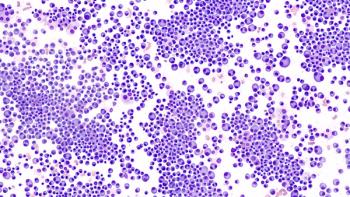
- February 2012
- Volume 3
- Issue 1
Oncology
Abnormal Call Activity Harbinger for Invasive Breast Cancer
At the Fourth American Association for Cancer Research Conference on the Science of Cancer Health Disparities in Washington, DC, researchers presented results of a study that showed breast cancer cells can be detected before they even appear.
The researchers from Duke University looked at 2 groups of 39 and 38 highrisk premenopausal African American women who had primary relatives who died of breast cancer at an early age. Of the patients who developed early accelerated breast cancer, it was possible to detect an aggressive phenotype at onset before invasive breast cancer began. The phenotype is marked by a phase known as atypia, when precancerous cells begin to behave abnormally. The researchers went further by classifying 3 activation patterns during this phase, including the well-known signaling pathway AKT/mTOR and the Warburg effect, which are seen in aggressive triple-negative breast cancer. When the Warburg effect occurs, the cancer cells begin to devour glucose at remarkable rates.
Once detected, these early stages of cancer development can better guide treatment decisions, researchers believe. Moreover, observing cells in the Warburg effect can provide an incentive for women with prediabetes to starve precancerous cells of glucose by using treatment modalities like weight loss, exercise, and metformin.
Relapsed Breast Cancer Patients May Benefit from Regular Biopsies
In a study presented in Stockholm, Sweden, at the European Multidisciplinary Cancer Congress, researchers demonstrated that breast cancer patients are poised to benefit greatly from regular biopsies performed in order to prevent invasive relapses.
The researchers evaluated breast cancer patients in Stockholm who experienced disease recurrence from January 1997 to December 2007. Receptor status was assessed in the primary tumor after the first relapse. The researchers found that estrogen receptor (ER) status changed in almost 34% of the 119 women, changing from positive to negative in 16% during the course of their disease, from negative to positive in 12.6%, and alternating between positive and negative in 5%.
The researchers determined that this ER instability is important in determining appropriate treatment options. Although a change from negative to positive receptor status allows more treatment options to become useful, changes in receptor status appear to adversely affect outcome. A change in receptor status means the need to do biopsies in patients with relapsed disease is imperative in determining appropriate therapies.
Taxane-Induced Neuropathy Does Not Predict Outcomes
At the 2011 Breast Cancer Symposium in San Francisco, California, in September, researchers from Indiana University’s Simon Cancer Center in Indianapolis presented the results of a study that enrolled 4950 women with breast cancer to determine if patients who experience taxane-induced neuropathy respond better to treatment than patients who do not. Many clinicians believe that patients who experience the harsh side effect of neuropathy due to paclitaxel have better outcomes than patients who do not experience it.
The patients were diagnosed with axillary lymph node—positive or high-risk lymph node–negative breast cancer and received at least 1 dose of paclitaxel or docetaxel. Rates of grades 2 to 4 neuropathy were 16% in the docetaxel groups and ranged from 20% to 27% in the paclitaxel groups. The researchers found no overall relationship between neuropathy and disease-free survival and overall survival in the population for any of the treatment arms.
The scientists did determine that predicting if a patient will develop neuropathy can be useful in guiding treatment and improving therapeutic individualization. One way to do this is to identify single nucleotide polymorphisms in genes shown to be responsible for neuropathy, such as RWDD3, which can serve as a biomarker for susceptibility to taxane neuropathy.
Fast Fact:
According to the National Cancer Institute estimates for 2011, there will be approximately 230,480 new cases of breast cancer in women with 39,520 deaths, and 2140 new cases of breast cancer in men with 450 deaths.
About the Author
Michael C. Wisotsky, PharmD, RPh, practices in Shrewsbury, New Jersey.
Articles in this issue
almost 14 years ago
Bristol-Myers Squibb's Orenciaalmost 14 years ago
REMS Standardsalmost 14 years ago
Are You Prepared for the ICD-10 Changes?almost 14 years ago
The Importance of Freedom to Operate for Specialty Biopharmaceuticalsalmost 14 years ago
Genentech's Zelborafalmost 14 years ago
Specialty Pharmacy: Making a Differencealmost 14 years ago
Loyalty: The Measure of Valuealmost 14 years ago
Accountability and Collaborationalmost 14 years ago
Specialty Pharmacy Management of Goutalmost 14 years ago
Taking Care of Transplant Patients: A Look at ModernHEALTHNewsletter
Stay informed on drug updates, treatment guidelines, and pharmacy practice trends—subscribe to Pharmacy Times for weekly clinical insights.





















































































































































































































